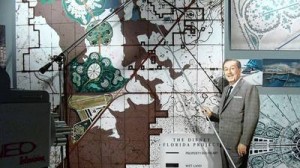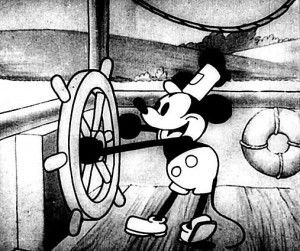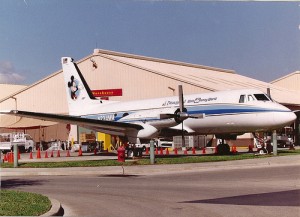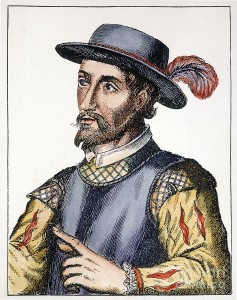50 years ago, Walt Disney saw Orlando as the perfect site for New Kingdom
Fifty years ago tomorrow, Orlando woke up to a fine fall day like the kind advertised in the tourist brochures in northern travel offices. Sapphire skies stretched over citrus groves, green scrub palmetto and countless pockets of blue lakes, where white egrets filled the tops of cypress trees not yet brown.
In the neighborhoods in and around the city's core, gray Spanish moss draped the limbs of evergreen oaks, and a few red maples were beginning to turn. Aside from these latter deciduous trees, though, evergreen palms and pines colored most of what anyone would see when they looked outside their open windows in Rosemont, Azalea Park or the aptly named Pine Hills.
It was about 60 degrees that morning, and the high would reach only 81, if even that. Summer's relative humidity had given way to a more tolerable dewpoint, and there would be no rainfall on such a pleasant autumn day. Instead, Orlando and the rest of the outlying region would bask in the sunshine for which the state was known.
The mild weather and the mostly evergreen terrain would give credence to what the tourist brochures at the time promised: This region was a kingdom of sunshine and a perpetual living landscape, a subtropical clime far removed from the fall chill of northern cities and states.
At the time, Orlando and the rest of Central Florida may not have been as well-known to the rest of the country as sun-tanned Miami or sea-storied Key West. Nor was it as famous as Cocoa Beach, where you could watch buff young men ride the ocean on surfboards or look skyward and see how smart young men were sending flaming rockets headlong into the New Frontier.
Yet here, in the middle of the peninsula, was an eden. All you had to do was find your way here. And 50 years ago, on a typical fall day in Central Florida, one very important man did.
Orlando - Today
Today, you can go down south of Orlando to where the Florida Turnpike crosses Interstate 4. There you'll see shopping malls, themed attractions and fast-food restaurants that cater to an out-of-state assemblage of visitors who come here to see the sights and to experience the thrills but never to put down roots and stay for very long. Time-share complexes and water parks compete for attention, as do endless retail businesses and storefront after storefront of T-shirt shops and neon-lighted souvenir stands. Arising above it all is the unceasing hum of traffic on the two main highways that crisscross the region six miles or so south of downtown Orlando.
But 50 years ago, at the same site, you would see practically nothing except … well, practically nothing. At least, nothing of note other than Central Florida's typical muddy and alligator-filled sloughs, sinkhole-formed lakes teeming with fish, and palm-covered and palmetto-tangled flatlands.
At the time, that wouldn't be surprising, given that, just a few years earlier, the 1960 census showed Orlando had a population of just 86,880, while Orange County's was only 262,655.
South of Orlando, in Osceola County, Kissimmee had about 12,000 residents and two main economic mainstays – citrus packing and ranching. The area's few two-lane hardtop roads and vast expanses of cattle land and citrus groves were testament to the openness of the country and the scarcity of its human inhabitants.
Like any eden, Central Florida was beautiful to the eye and temperate to the flesh, even in fall and winter, and it was, of course, a sportsman's paradise because of this. Yet, beyond the Air Force base southeast of Orlando, where civilian jets were just starting to take off and land under a civilian-military partnership, or the citrus groves and cattle land surrounding the city and all the smaller towns throughout the immediate region, there was little of what an out-of-town traveler at the time might view as a must-see attraction worth driving to from Atlanta or Miami.
Yet, from high above, looking out the window of a twin-engine Beechcraft Queen Air, the man from California saw something beyond the greenery under the ever-present sunshine. He saw something more than just the great outdoors and the sportsman's vacation respite from the seasonal cold.
Flying over Central Florida on that fine fall day, Walter Elias Disney looked down at the green land punctuated by the blue water of a hundred inland lakes, and he saw the future.
It was the future of his company and its economic success, of course. But it also was the future of his lifelong plans for creating something just as meaningful to him personally as his California theme park had been when it had opened eight years earlier. This time, though, Disney's dream was bigger and his overarching idea was to prevent it from suffering from the same problems then plaguing his first themed attraction as the tacky tourism ugliness of Anaheim closed in around the splendor of Sleeping Beauty Castle.
Orlando - 50 Years Later
Today, 50 years later, the story is well-known yet can be easily forgotten or overlooked by those of us who weren't here before Disney arrived and made a momentous decision that would forever change this region.
The historic flight got underway on Nov. 17, 1963.
Aboard the flight with Disney were some of his most trusted advisers and confidants. These men had names that many park guests still might recognize even if they don't know who the people behind them were or what role they once served in creating a magical kingdom in the middle of a verdant land far removed from Midwest industrial centers or avenues of commerce in the Northeast. These names still echo in Central Florida, read aloud by tourists gazing at faux shop windows along Main Street U.S.A. or the names of ferries that ply the Seven Seas Lagoon.
The group with Disney on that multi-day flight from California included Buzz Price, Joe Fowler, Donn Tatum, Jack Sayers and Esmond Cardon "Card" Walker.
Harrison "Buzz" Price was a research economist who, aside from Disney, himself, was most responsible for physically placing Disneyland and Walt Disney World where the themed attractions are today. Disney relied on Price's guidance multiple times, including when he earlier had scouted Central Florida before 1963 and informed Disney that the mild winters here would be advantageous to any expansion plans Walt might harbor.
Fowler was a former U.S. Navy rear admiral who helped Disney create Disneyland by serving as the construction chief for that project. He also would go on to assist with the creation of Walt Disney World, and most park guests today probably recognize his name as the same atop one of the ferries that travel from the Ticket and Transportation Center to the Magic Kingdom.
Tatum had served in multiple high-profile roles with Disney's operations and later would go on to help lead the creation of both Walt Disney World and its Epcot resort. He also was the first non-Disney family member who one day would be named president of Walt Disney Productions. His name adorns a window overlooking Main Street U.S.A.
Sayers was an ex-CBS broadcaster and executive and a longtime friend of Disney who would go on to serve as chairman of Disneyland's Park Operating Committee. His name can be seen on a window above Main Street U.S.A., as well.
Walker literally worked his way up at The Walt Disney Co., starting in the mailroom, serving in a camera department, taking time off to serve in the U.S. Navy in WWII, then returning to The Walt Disney Co. and eventually working his way up to vice president of advertising and sales before becoming the company's chief operating officer. After Roy E. Disney died in 1971, he would be the company's president, too. Because of his efforts, the company expanded to overseas markets, and he even went on to create the Disney Channel in 1982.
These men, as bright and endeavoring as they were, didn't just pile into the plane with Walt and fly east to have a look around. In fact, the trip to Florida wasn't the first time Disney had considered the Sunshine State as serving a role for his expansion plans, even if he didn't have a firm idea of what shape those plans might take as the 1950s came to a close.
As early as 1959, Disney had considered a handful of proposals for creating something tourism- or entertainment-driven here in the Sunshine State. Ocala was a potential site spoken of often in the highest offices in the company. Palm Beach even went as far as to extend an invitation and have Disney see the small parcel of land that area would have been happy to offer up for an entertainment venture.
Yet time and again, the ideas came to naught because of various obstacles, all of which weren't just financial.
But, by 1963, Disney's company and its leaders were moving closer to creating another Disneyland-like experience east of the Mississippi. And for good reason.
Though it seems hard to believe today, most of Disneyland's ticket-buying guests lived on or near the West Coast. Statistically, few Disneyland visitors came from east of the Mississippi River in the late '50s and early '60s.
Added to this was the frustrating experience Disney found himself grappling with not long after the gates first opened at his Anaheim park. Because, though Disney could design and build entire worlds of his own creation and choosing within the property boundaries of Disneyland, he was helpless in preventing the creeping intrusion of drive-up motels, bargain tourist shops and other less-than-themed quality attractions that surrounded his beloved creation.
Disney knew he needed another theme park, and this time he was determined to control all aspects of its creation and its existence – its size, its physical buffer to surrounding communities, and even its long-pondered theme that would surpass any the world had known at the time, even if they would come to see elements of it at the 1964 World's Fair in New York.
It Was Nearly Not Orlando...
The eastbound flight in November took Disney to potential sites in St. Louis, Niagara Falls and other areas. At each stop, the group would tour the area and debate the pros, the cons and the costs.
Disney, at the time, viewed the St. Louis site favorably, though that all changed when a slightly intoxicated Busch brewing executive loudly proclaimed over dinner that any theme park that didn't sell alcohol to its guests was doomed to economic failure.
Disney the man, who enjoyed drinks with friends like most other men and women of his day or any other, calmly took in the public rebuke. He did not argue with Augustus Busch Jr., the head of the Anheuser-Busch brewery dynasty that made St. Louis what it was and still remains. Yet Disney the businessman also had specific ideas about what he wanted his family-centric park to be, and he knew that once the turboprop took off the following morning, St. Louis no longer would be a gateway city for his grand aspirations.
From St. Louis, Disney and his advisers flew to the Niagara Falls area. The site was viewed favorably, yet Disney knew the winters there would limit the operation of any park in the region. The group then visited the Baltimore-Washington, D.C., area, as well.
Finally, the trip came toward a close with a landing in Central Florida, where Disney and his advisers first toured Ocala, by car, as well as other regional sites, including the single big attraction in Central Florida in that day, the Citrus Tower in Clermont. Then the men went back to the airport and boarded their plane again Nov. 22 to fly over Central Florida and other sites farther south and west one last time before returning to California.
As the plane flew south of Orlando, Disney and others on the flight looked down at the rich landscape that filled their view. Below were citrus groves and green palms, blue lakes and wildlife that filled both brush and sky. Most everywhere was the green expanse of Central Florida's Atlantic coastal plane. It was a sunny fall day, and, no doubt, everything below the plane's flight path stood out in a subtropical wonder foreign to anyone living north of Ocala or Jacksonville.
As Disney and the group of men aboard the twin-engine plane looked down, they would have seen felled trees and drained lakes across what once was green pasture land, seemingly endless citrus groves and fishing retreats alongside blue lakes. In the roadway's path, though, greenery from the natural earth would have been turned by spade and bulldozer, and left behind would have been the hard earth and the industrial effect of the hard work of man that soon would bring the gas-powered noise of more traffic as carloads of first-time visitors would venture into Central Florida.
But to Disney, who was looking for a site that would attract tourists as easily as his animated films pulled people into theaters, it was just as beautiful as the reed-fringed banks of Bay Lake and the sabal palms that fringed the headwaters of the Everglades along Shingle Creek.
Disney and, perhaps, others aboard the plane knew what they were seeing below. One roadway, Interstate 4, bisected the Sunshine State from east to west. The other, Florida's Turnpike, would connect South Florida with Orlando and, more importantly, go farther north to connect to Interstate 75, a roadway that already brought untold legions of sunshine-seeking tourists to the state from the North.
And, yet, through the middle of it all was an ugly gash of human progress, a scar of dirt and gravel, metal and freshly poured concrete. It was the construction of Florida's Turnpike, tearing through the countryside south of Orlando and heading northwestwardly across the recently-completed ribbon of asphalt that was Interstate 4.
According to Richard Foglesong's "Married to the Mouse," a 2001 work of immense wealth of details about how Disney created his kingdom here in Central Florida, there was a decisive moment during the plane's flight south of downtown. It was there, somewhere circling over Central Florida south of Orlando, that Disney looked down, saw the land he wanted to make his own and said, "That's it."
And with that, the dawn of what was to become Walt Disney World changed Central Florida's world forever.
Orlando, 500 Years Ago
Some 500 years ago, Juan Ponce de Leon stumbled onto this peninsula from the east and set into motion a world-changing course of events. Fifty years ago, Walter Elias Disney came to Florida from the west, and what he set in motion for Orlando and the region forever changed everything here almost as dramatically over the short course of time seen in half a century.
Today, of course, the tourist brochures in travel offices portray a different image of Orlando than the one depicted 50 years ago.
Pick up one in a travel office in Detroit or Dubai, Chicago or Rio de Janeiro, and most likely travelers don't even have to read the contents once they see the city's name on the cover. Even if people have never traveled here, they still most likely know about the city and its themed attractions. They know about Mickey Mouse and Cinderella Castle. They know about Shamu, too, and the Harry Potter attraction. They even probably have heard about the city's high-tech industry and its University of Central Florida, its Orlando Magic and now its new major-league soccer franchise.
They know about it all, because a man with a vision came here and saw the natural beauty in all its color and possibility, and decided that this was an eden in which to grow his own aspirations.
They know Orlando because Walt Disney saw the city and the region and knew that here he could create a magical kingdom and a city of tomorrow. He knew he could create the future.
Off the back of Disney building Magic Kingdom came the need for luxury vacation homes for all those visitors to Orlando to rent, but that is another story...





